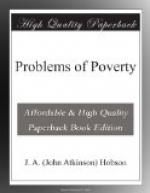Speaking of Trade Unions, he sums up—“In fact the executive committees of all the chief Unions are to a very large extent hostile to strikes, and exercise a restraining influence”—a judgment the truth of which has been largely exemplified during the last two or three years. But our hopes and desires must not lead us to exaggerate the size of these peaceable factors. Conseils de prud’hommes on the continent, boards of arbitration and conciliation in this country, profit-sharing schemes in Europe and America, are laudable attempts to bridge over the antagonism which exists between separate concrete masses of capital and labour. The growth of piecework and of sliding scales has effected something. But the success of the Board of Conciliation and Arbitration in the manufactured iron trade of the north of England has not yet led to much successful imitation in other industries. Recent experience of formal methods of conciliation and of sliding scales, especially in the mining, engineering, and metal industries, as well as the failure of some of the most important profit-sharing experiments, shows that we must be satisfied with slow progress in these direct endeavours after arbitration. The difficulty of finding an enduring scale of values which will retain the adherence of both interests amidst industrial movements which continually tend to upset the previously accepted “fair rates,” is the deeper economic cause which breaks down many of these attempts. The direct fusion of the interests of employers and employed, and in some measure of capital and labour, which is the object of the co-operative movement, is a steadily growing force, whose successes may serve perhaps better than any other landmark as a measure of the improving morale of the several grades of workers who show themselves able to adopt its methods. But while co-operative distribution has thriven, the success of co-operative workshops and mills has hitherto been extremely slow. A considerable expansion of the productive work of the co-operative wholesale societies within the last few years offers indeed more encouragement. But at present only about 21/4 per cent. of English industry and commerce, as tested by profits, is under the conduct of co-operative societies. Hence,




